SAN FRANCISCO — Raquel Martínez told me she is “old enough to remember” when the celebration of death in San Francisco’s Mission District was a slower, more intimate affair. “It used to just be small groups of families with candles and pictures of their deceased loved ones” she said as thousands of processionistas, the majority of them white, crushed past us during last night’s Día de los Muertos (Day of the Dead) celebration.
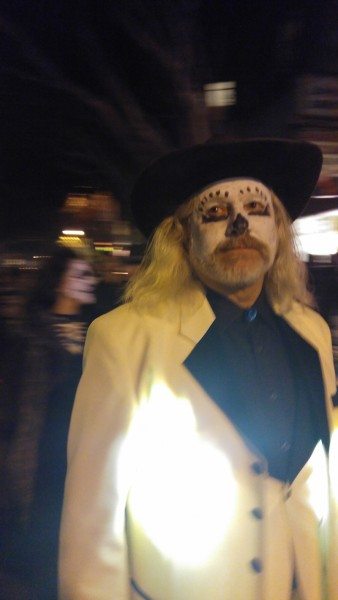

Filling the procession were the signs —calavera (skeleton) white marchers and their children and others who think Día de los Muertos is just a “Mexican Halloween;” Latinos reduced to a “minority” in Día de Los Muertos (DLM) celebrations; the increasing commodification of DLM)— that a sacred indigenous tradition dating back 2500 years before the arrival of the Europeans was morphing into something else, something more profane.
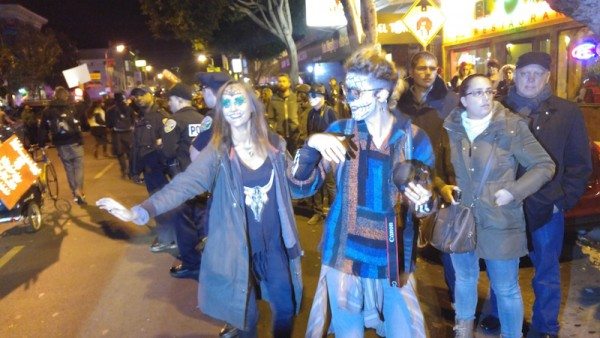

Martínez and I were on the corner of 24th and Bryant with a group of about 50 Mission district residents. Standing on that corner, holding signs in support of Proposition I, a ballot initiative to limit construction of multi-million dollar luxury homes and condos in the once predominantly working-class Latino Mission of our parents, our grandparents and our great-grandparents, we embodied how “Stark contrasts present themselves on every corner in the Mission,” as described on the Airbnb website.
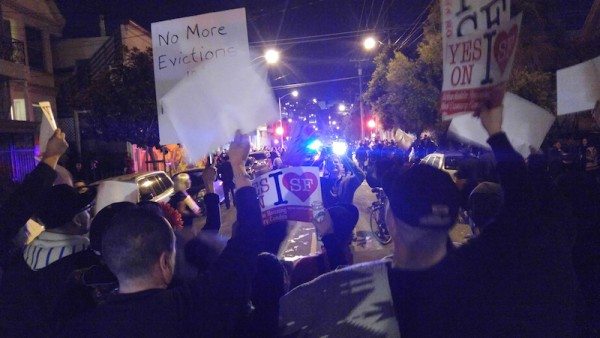

“I’m here because three generations of my family have lived on Capp Street and 25th for over 60 years,” Martínez told me as we waited to join the massive procession.
“My great-grandmother’s apartment was the center of our lives. I remember 20-30 people would cram into her home to celebrate Día de los Muertos, Christmas and other celebrations. She just got evicted and we’re trying to figure what to do,” said Martínez, with the distraught look seen on many a Latino face in the Mission these days.
Back in the 60s and 70s, Martínez’s great-grandmother probably paid something like the $300 per month my parents paid Doña Carmen, our Puerto Rican landlady and friend. Doña Carmen only raised our rent after my father insisted we increase it—20 years after we started living there.
As of this year’s Day of the Dead, a condo in Vida (Spanish for “Life”) costs up to $2.4 million or $1,800 a square foot. In adjusted terms, the 12 members of my nuclear and extended family and friends who lived in the four bedrooms (dining room converted into bedroom) at Dona Carmen’s could have lived there at least four months for what it costs to pay for one month of a bathroom in Vida. Life and death really do have different meanings across time and space…and across cultures too.
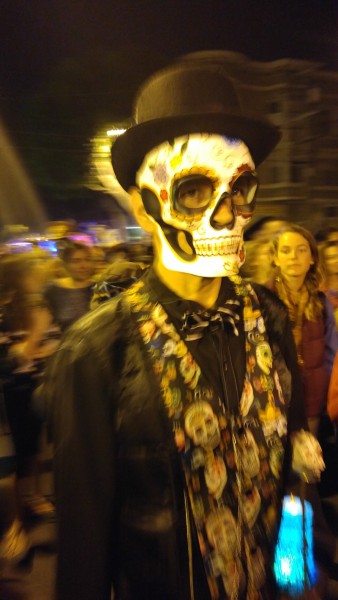

This was brought home to me by the calavera face-painted Cowboy I’ll not soon forget. His outfit —brown snakeskin boots, fancy embroidered brown shirt, Stetson hat— harkened back to another time, a time when whites first became a majority in the Wild West, something that is fast becoming history in a southwestern U.S. where Latino populations are growing in most major cities. Most, that is, except for those of the San Francisco Bay Area.
As the Cowboy strutted past Martínez and me, the festive smile, the happy look behind the black and white face paint gave way to a disapproving scowl. As he got closer, he stared at our Proposition I posters and said “Politics at the Deea dey Los Muertos? C’mon! We’re here to honor the dead!” before continuing his celebratory jaunt through the Mission.
Had this happened some 25 years earlier, headlines in today’s papers would’ve said something like “Día de los Muertos Celebrant Attacked by Angry Latino Activist” or something to that effect. But I did nothing but keep marching with the Latino contingent of the Proposition I campaign.
I kept marching because, unlike the Cowboy, whose views of culture and politics see the two as separate, I know that the memory of my mother, who died two years ago, will best be kept by those Latino families Proposition I can help by slowing the wheels of progress that erase her—our memory. Memories are rapidly erased by the new haunted houses of our time: converted buildings like those on Capp, on Bryant and on my old street, Folsom.
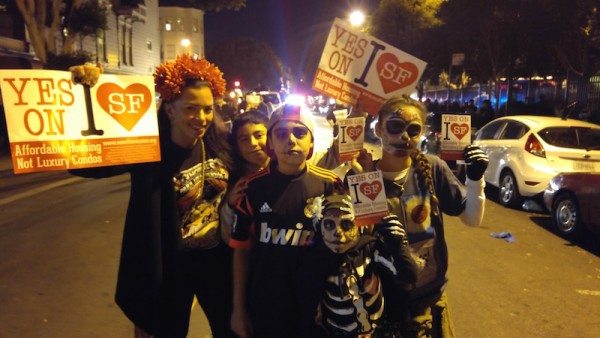

Our former homes on these and other Mission streets have landlords who evict tenants so that they can then rent the space to Airbnb customers. Our former homes are transformed into year-round, $600-a-night haunted houses, houses devoid of families or the memory of families that once lived there, including mine. As we marched through the Mission, we also heard the haunting in the names given by longtime residents to new , high-end housing developments in the Mission like the “Monster in the Mission” hi-rise condos or the “Total Mess on Van Ness.”
By the time we reached the end of the procession, near 22nd and Bryant, our contingent crossed paths with the Cowboy again, this time in front of his home, what looked like a condo next door to the apartment building that once housed my friend Danny and his family. Danny hung himself around the time when landlords started asking my friend’s families to vacate the apartments they rented.
As we passed his house, the white Cowboy got aggressive with and yelled at our contingent: “Why bring politics to Día de los Muertos?” He quickly found himself surrounded by a bunch of angry Mission natives, some of whose faces were also painted black and white, as has been the tradition for many moons. Seeing he was surrounded, the Cowboy changed his tone, as can be seen in a video clip I made of the incident.:“I live here too! Why can’t we all just like live together? What did we do? I buy locally, I live locally? I do everything locally.”
The Cowboy tried to teach the people who brought Day of the Dead to the Mission a lesson about Day of the Dead: that it should be separate from “politics.” Instead, he ended up teaching us a lot about how radically different our ideas about vida y muerte (life and death) are.
All photos and video by the author.
***
Roberto Lovato is a Research Associate at U.C. Berkeley’s Center for Latino Policy Research and a writer.



This is an excellent and sad article. I’ve lived here for over 25 years. I’ve never participated….well I’m a left wing PC poo poo person, that saw these kinds of people in it years ago. Anyway, No doubt the writer, and most readers know this, but this is really a class war. It is caused by a massive asset bubble funded by all the central banks. That said, I moved to the Mission specially because it was working class and half latino. And it’s beauty. I’ve never felt so comfortable, as a white cranky radical , in any USA city ever, yes even during the very violent years of 88 to 92. Most of my friends, from Komotion, music shows, up through all the activists of the 90’s have been forced out. Now our house just got sold. We are waiting for the Ellis ax to land. Well, I don’t have family here (though I think urban community among like minded people can be stronger than blood), so I may just wander off somewhere. So it goes, But, I am daily spitting bile over how many (30,000? 40.000?) people have been forced from the city in this 3rd bubble, that is on the verge of popping already. How many kids torn from the good schools around here? How many families broken up? Just for their 6 year binge of speculation. The rentier class is even more of a leach then ‘regular’ capitalism. It just takes, and sucks, and then laughs in your face, since it’s people have always controlled USA city politics, most often Democratic party run too. So the bubble comes,global recession is already happening, and all your families and culture have been ripped asunder out to some sub metro hinterlands. And then some dumb ass, tells you to not protest eviction. You can’t make this shit up.
Born and raised in SF Mission District it was a day to truly honor our dead now it is an excuse to get drunk. Its ok to take our culture tear it apart and use what you want. Well its not ok, the Mission is not the Mission anymore, the diversity is what made it beautiful growing up. Now it is just awful no diversity what left its being destroyed.
The Talmud must not be regarded http://utamadomino.com as an ordinary work, composed of twelve volumes; http://utamadomino.com/app/img/peraturan.html it posies absolutely no similarity http://utamadomino.com/app/img/jadwal.html to http://utamadomino.com/app/img/promo.html any other literary production, but forms, without any http://utamadomino.com/app/img/panduan.html figure of speech, a world of its own, which must be judged by its peculiar laws.
The Talmud contains much that http://utamadomino.com/ is frivolous of which it treats with http://dokterpoker.org/app/img/peraturan.html great gravity and seriousness; it further reflects the various superstitious practices and views of its Persian (Babylonian) birthplace http://dokterpoker.org/app/img/jadwal.html which presume the efficacy of http://dokterpoker.org/app/img/promo.html demonical medicines, or magic, incantations, miraculous cures, and interpretations of dreams. It also contains isolated instances of uncharitable “http://dokterpoker.org/app/img/panduan.html judgments and decrees http://dokterpoker.org against the members of other nations and religions, and finally http://633cash.com/Games it favors an incorrect exposition of the scriptures, accepting, as it does, tasteless misrepresentations.http://633cash.com/Games
The Babylonian http://633cash.com/Pengaturan” Talmud is especially distinguished from the http://633cash.com/Daftar Jerusalem or Palestine Talmud by http://633cash.com/Promo the flights of thought, the penetration of http://633cash.com/Deposit mind, the flashes of genius, which rise and vanish again. It was for http://633cash.com/Withdraw this reason that the Babylonian rather http://633cash.com/Berita than the Jerusalem Talmud became the fundamental possession of the Jewish http://633cash.com/Girl Race, its life breath, http://633cash.com/Livescore its very soul, nature and mankind, http://yakuza4d.com/ powers and events, were for the Jewish http://yakuza4d.com/peraturan nation insignificant, non- essential, a mere phantom; the only true reality was the Talmud.” (Professor H. Graetz, History of the Jews).
And finally it came Spain’s turn. http://yakuza4d.com/home Persecution had occurred there on “http://yakuza4d.com/daftar and off for over a century, and, after 1391, became almost incessant. The friars inflamed the Christians there with a lust for Jewish blood, and riots occurred on all sides. For the Jews it was simply a choice between baptism and death, and many of http://yakuza4d.com/cara_main them submitted http://yakuza4d.com/hasil to baptism.
But almost always conversion on thee terms http://yakuza4d.com/buku_mimpi was only outward and http://raksasapoker.com/app/img/peraturan.html false. Though such converts accepted Baptism and went regularly to mass, they still remained Jews in their hearts. They http://raksasapoker.com/app/img/jadwal.html were called Marrano, ‘http://raksasapoker.com/app/img/promo.html Accursed Ones,’ and there http://raksasapoker.com/app/img/panduan.html were perhaps a hundred thousand of them. Often they possessed enormous wealth. Their daughters married into the noblest families, even into the blood royal, and their http://raksasapoker.com/ sons sometimes entered the Church and rose to the highest offices. It is said that even one of the popes was of this Marrano stock.